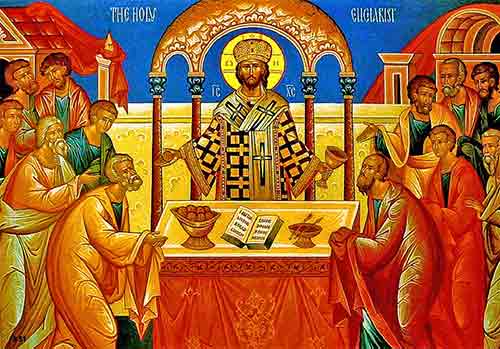
This post follows my reflection on
- the Eucharistic Prayer starting page 420 in A New Zealand Prayer Book He Karakia Mihinare o Aotearoa (NZPB/HKMA)
- the Eucharistic Prayer starting page 436
- the Eucharistic Prayer starting page 467
- the Eucharistic Prayer starting page 485
and their revisions. - the Eucharistic Prayer starting page 512 (a framework for producing your own)
- Alternative Great Thanksgiving E
- An Alternative Form for Ordering the Eucharist
In reflecting on the quality of a Eucharistic Prayer (a Great Thanksgiving), here are some of the things I’m looking out for:
- Clearly a prayer of thanksgiving – consecrating by the community giving thanks (led by the gathered community’s presider) for the great acts of God
- following the Jewish Berakah structure (Praise – Proclaim – Petition – Praise)
- Easily-remembered, consistent responses and acclamations (so preferably poetic and singable) for the gathered community so that they are not focusing on a book (or a projector screen)
- Inclusive and expansive language
- A prayer that flows well, keeps to a consistent tone, and has a broad enough theology to cover acceptable interpretations
Let’s look at some other Eucharistic Prayer allowed in the Anglican Church in Aotearoa, New Zealand and Polynesia.
A Service of Holy Communion (p.732)
The Eucharistic Prayer beginning page 732 in NZPB/HKMA has much that we can reflect on, reflections that can be used as lenses to look at other Eucharistic Prayers.
“The priest says” (page 732)
In other Eucharistic Prayers, NZPB/HKMA has “The presiding priest…”. For no Eucharistic Prayers in NZPB/HKMA does it say “The [presiding] bishop or priest…” Contrast this with the NZPB/HKMA baptism rite where, on each and every occasion, it says, “The bishop or priest…” I would very much prefer (since we are talking about improving Great Thanksgiving Prayers) that, for each and every Eucharistic Prayer, NZPB/HKMA also said, “The presiding bishop or priest…” As it stands, NZPB/HKMA gives the impression that a bishop presides at the Eucharist because a bishop is a priest. I would like the interpretation left open that it is the bishop who is the primary presider at the Eucharist, and that priests preside on behalf of the bishop/in the bishop’s absence.
Just as Alternative Great Thanksgiving A is “An alternative to Thanksgiving of the People of God on page 420”, so this prayer (on page 732) is another abbreviation of the prayer starting on page 420.
Both prayers replace “it is our joy and our salvation, holy Lord, almighty Father, everlasting God, at all times and in all places” with “everliving God” (page 421) with “everliving God”.
The original prayer (beginning page 420) has 502 words (taking 4-5 minutes to proclaim well). The Alternative Great Thanksgiving A has 468 words (7% fewer words – saving about a quarter of a minute). Removing “the marked passages [which] may be omitted“, the prayer starting on page 732 has 274 words (about half the time to proclaim than the one it abbreviates).
I have, above, outlined my understanding of the structure of a Eucharistic Prayer (the Jewish Berakah structure: Praise – Proclaim – Petition – Praise). Omitting the “marked passage” (as is allowed) on page 733 would mean this prayer does not have a final doxology, it does not conclude with praise. I think this is a significant issue. It also underscores a poor understanding of the structure of a Eucharistic Prayer by the Prayer Book Commission, the General Synod that passed this, and the others who ratified that passing.
This rite is described as “For use with individuals or small groups to meet special pastoral needs” (page 729). The description that follows makes it clear that this rite is for those who “are prevented by frailty or sickness from taking part in the common worship of the Church“. It has, nonetheless, been used in the regular Sunday parish Eucharist – the justification being that this particular parish gathering is a “small group”.
There is clearly a yearning for a Eucharistic Prayer that takes only two to three minutes to proclaim. This also points to an impoverished Eucharistic spirituality.
.


